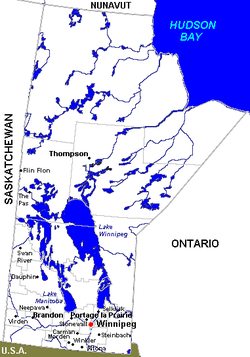
A town is an incorporated urban municipality in the Canadian province of Manitoba. [1] Under current legislation, a community must have a minimum population of 1,000 and a minimum density of 400 people per square kilometre to incorporate as an urban municipality. [2] As an urban municipality, the community has the option to be named a town, village or urban municipality. [2] It also has the option of being named a city once it has a minimum population of 7,500 (there are no towns currently eligible for city status; the closest is Niverville, with a population of 5,947 in the Canada 2021 Census). [2]
Contents
Manitoba has 25 towns [3] that had a cumulative population of 60,963 in the 2021 census. [4] The province's largest and smallest towns by population are Niverville and Grand Rapids with populations of 5,947 and 213 respectively. [4] The province's largest and smallest towns by land area are Gillam and Arborg with land areas of 1,994.44 km2 (770.06 sq mi) and 2.22 km2 (0.86 sq mi) respectively. [4] The province previously had 50 towns before a series of provincially mandated amalgamations took effect on January 1, 2015.
Communities meeting the population minimum are not always incorporated as urban municipalities. There are 22 unincorporated communities with a population of more than 1,000 within Manitoba's rural municipalities. The largest of these is Oakbank in the Rural Municipality of Springfield with a population of 4,604.[ needs update ]